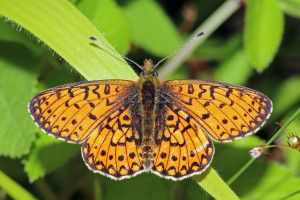 People occasionally ask me why I keep my large, sometimes unruly garden, when it is clearly a lot of work. The questions usually come when the weather is hot, sticky and generally infernal, or when I have been overdue in mowing the square of lawn in the front yard.
People occasionally ask me why I keep my large, sometimes unruly garden, when it is clearly a lot of work. The questions usually come when the weather is hot, sticky and generally infernal, or when I have been overdue in mowing the square of lawn in the front yard.
Of course, gardening brings me joy, relieves stress and improves the quality of my life. But the other day, as I was watching a fritillary butterfly dining on some threadleaf coreopsis, I thought, “I garden because fritillaries love violets.”
This takes some explaining. While the fritillary butterfly will sample nectar from a wide variety of flowers, both native and non-native, its sole larval food is the common violet, Viola soraria. I grow lots of violets, or, more accurately, I allow lots of violets to grow in my lawn and garden beds. I have the common purple ones, white ones and freckled types, all of which bloom in spring and spread freely. Some people that I know, especially men who want putting green-like lawns, waste a lot of time and energy fighting violets. I do not. My gardening style allows for lots of randomness, and the violets are part of that. I figure that if gratitude were part of the fritillary mindset, they would thank me. More likely, they just know the violets are there in large numbers and make use of them.
I also garden because bees like oakleaf hydrangeas. I have two of them, both of which are the size of small elephants. At the moment they are awash in huge creamy flower panicles, which are just beginning to turn pink around the edges. Yesterday I sat on my front steps and watched all kinds of bees, from the big, slow-moving bumblebees to the darting, hungry honeybees, moving among the florets. You could smell the fragrance of all those flowers and hear the low hum of the bees and other pollinators at work. Gardening slows you down and allows for those sensations.
Of course, I couldn’t sit for too long before noticing a few weeds among the just-opening coneflowers. While I was plucking those out, I saw the first silver-spotted skipper of the season. If you don’t know skippers, you should. They are technically butterflies—at least until the insect taxonomists change their designation yet again—but look like a cross between a small butterfly and a small moth. Like butterflies they are diurnal, doing their feeding and pollinating work while the sun shines.
Silver-spotted skippers are mostly brown, but have a big white spot on the undersides of each hind wing, which makes them easily recognizable, as they work their way around gardens. I see them most often in early to late summer. At my place they seem to go for whatever is on offer at the moment. Right now, they are frequenting the daisies, but later on they will gravitate towards the milkweeds and asters. Their larvae relish the leaves of members of the pea or legume family, like baptisias, black locust trees and even wisteria. This makes me feel at least a bit more kindly towards the rampant Chinese wisteria surging over and under the fence from my neighbor’s property.
Now that the coneflowers are about to put on their show, I think about the goldfinches, who relish the seeds. The time to see goldfinches at their best is spring and early to mid-summer, when the breeding males assume their courting dress of bright golden yellow feathers accented by black topknots and black and white wings. They are the closest you will get to having canaries in the garden—unless of course, your neighbor’s canary escapes. Females are mostly olive-drab in color, and the non-breeding males are equally nondescript.
Goldfinches also nest late in the season and use the downy fluff from thistles and similar plants to line their nests. For those who regard thistles as a nuisance, this is something to think about.
I also garden for the cardinals, which are gorgeous birds in and of themselves. In my yard they prefer to nest in the forbidding confines of the quince bush, which grows with wild abandon and bears sharp thorns that can be up to an inch long. Every spring after it blooms I vow to cut it back severely and every spring I hold off because the cardinal chicks have not yet fledged. The cardinals and the quince seem to have a symbiotic relationship. This benefits both species, but does not benefit garden tidiness.
I would love to have a totally tidy garden and there are days when I would love to have a little less garden work. After all, bags of mulch are not light. But mostly, I think the work is a labor of love and the effort relatively minor compared to the rewards. There are few things better for your soul than the sight of a silver-spotted skipper.
